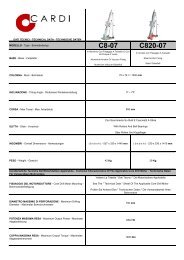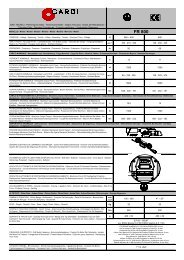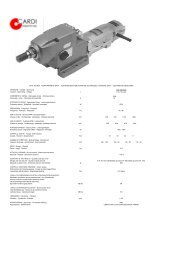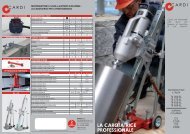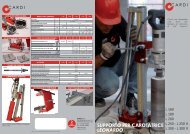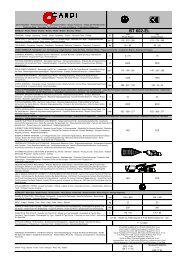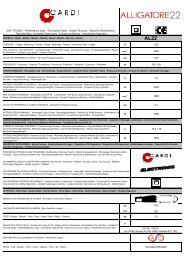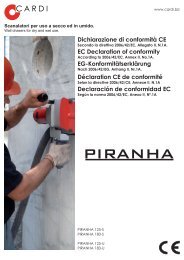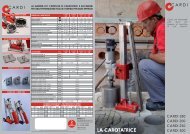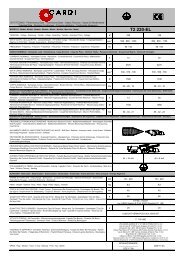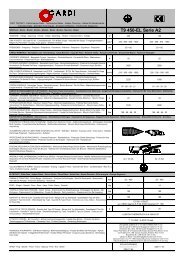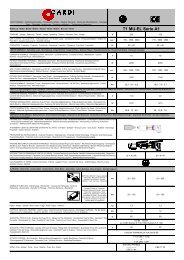You also want an ePaper? Increase the reach of your titles
YUMPU automatically turns print PDFs into web optimized ePapers that Google loves.
English 6<br />
Your <strong>CAR</strong>DI wall chaser is a power tool designed to make grooves into stone-like<br />
materials like reinforced concrete, bricks, masonry, natural stone, using laser-welded<br />
diamond blades only.<br />
Warning: do NOT use circular saw blades or other kind of blades not laser-welded.<br />
Failure to follow this warning may result in serious personal injury (fig. 8 and 9).<br />
General safety Rules<br />
WARNING! Read all instructions. Failure to follow all<br />
instructions listed below may result in electric shock, fire<br />
and/or serious injury. The term "power tool" in all of the<br />
warnings listed below refers to your mains operated (corded)<br />
power tool or battery operated (cordless) powertool.<br />
SAVE THESE INSTRUCTIONS<br />
1) Work area<br />
a) Keep working area clean and well lit. Cluttered<br />
and dark areas invite accidents.<br />
b) Do not operate power tools in explosive<br />
atmospheres, such as in the presence of<br />
flammable liquids, gases or dust. Power tools<br />
create sparks which may ignite the dust or fumes.<br />
c) Keep children and bystanders away while<br />
operating a power tool. Distractions can cause<br />
you to lose control.<br />
2) Electrical safety<br />
a) Power tool plugs must match the outlet. Never<br />
modify the plug in any way. Do not use any<br />
adapter plugs with earthed (grounded) power<br />
tools. Unmodified plugs and matching outlets will<br />
reduce risk of electric shock.<br />
b) Avoid body contact with earthed or grounded<br />
surfaces such as pipes, radiators, ranges and<br />
refrigerators. There is an increased risk of electric<br />
shock if your body is earthed or grounded.<br />
c) Do not expose power tools to rain or wet<br />
conditions. Water entering a power tool will<br />
increase the risk of electric shock.<br />
d) Do not abuse the cord. Never use the cord for<br />
carrying, pulling or unplugging the power tool.<br />
Keep cord away from heat, oil, sharp edges or<br />
moving parts. Damaged or entangled cords<br />
increase the risk of electric shock.<br />
e) When operating a power tool outdoors, use an<br />
extension cord suitable for outdoor use. Use of<br />
a cord suitable for outdoor use reduces the risk of<br />
electric shock.<br />
3) Personal safety<br />
a) Stay alert, watch what you are doing and use<br />
common sense when operating a power tool.<br />
Do not use a power tool while you are tired or<br />
under the influence of drugs, alcohol or<br />
medication. A moment of inattention while<br />
operating power tools may result in serious<br />
personal injury.<br />
b) Use safety equipments: always wear eye<br />
protection. Safety equipment such as dust mask,<br />
non-skid safety shoes, hard hat, or hearing<br />
protection used for appropriate conditions will<br />
reduce personal injuries.<br />
c) Avoid accidental starting. Ensure the switch is<br />
in the off position before plugging in. Carrying<br />
power tools with your finger on the switch or<br />
plugging in power tools that have the switch on<br />
invites accidents.<br />
d) Remove any adjusting key or wrench before<br />
turning the power tool on. A wrench or a key left<br />
attached to a rotating part of the power tool may<br />
result in personal injury.<br />
e) Do not overreach. Keep proper footing and<br />
balance at all times. This enables better control of<br />
the power tool in unexpected situations.<br />
f) Dress properly. Do not wear loose clothing or<br />
jewellery. Keep your hair, clothing and gloves<br />
away from moving parts. Loose clothes, jewellery<br />
and long hair can be caught in moving parts.<br />
g) If devices are provided for the connection of<br />
dust extraction and collection facilities, ensure<br />
these are connected and properly used. Use of<br />
these devices can reduce dust related hazards.<br />
h) Use auxiliary handles supplied with the tool.<br />
Loss of control can cause personal injury.<br />
4) Power tool use and care<br />
a) Do not force the power tool. Use the correct<br />
power tool for your application. The correct<br />
power tool will do the job better and safer at the<br />
rate for which it was designed.<br />
b) Do not use the power tool if the switch does not<br />
turn it on and off. Any power tool that cannot be<br />
controlled with the switch is dangerous and must<br />
be repaired.<br />
c) Disconnect the plug from the power source<br />
before making any adjustments, changing<br />
accessories, or storing power tools. Such<br />
preventive safety measures reduce the risk of<br />
starting the power tool accidentally.<br />
d) Store idle power tools out of the reach of<br />
children and do not allow persons unfamiliar<br />
with the power tool or these instructions to<br />
operate the power tool. Power tools are<br />
dangerous in the hands of untrained users.<br />
e) Maintain power tools. Check for misalignment<br />
or binding of moving parts, breakage of parts<br />
and any other condition that may affect the<br />
power tools operation. lf damaged, have the<br />
power tool repaired before use. Many accidents are<br />
caused by poorly maintained power tools.<br />
f) Keep cutting tools sharp and clean. Properly<br />
maintained cutting tools with sharp cutting edges<br />
are less likely to bind and are easier to control.<br />
g) Use the power tool, accessories and tool bits<br />
etc., in accordance with these instructions and<br />
in the manner intended for the particular type of<br />
power tool, taking into account the working<br />
conditions and the work to be performed. Use of<br />
the power tool for operations different from<br />
intended could result in a hazardous situation.<br />
5) Service<br />
a) Have your power tool serviced by a qualified<br />
repair person using only identical replacement<br />
parts. This will ensure that the safety of the power<br />
tool is maintained.



